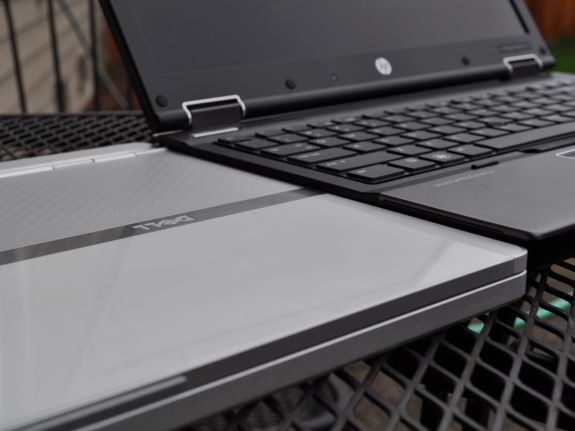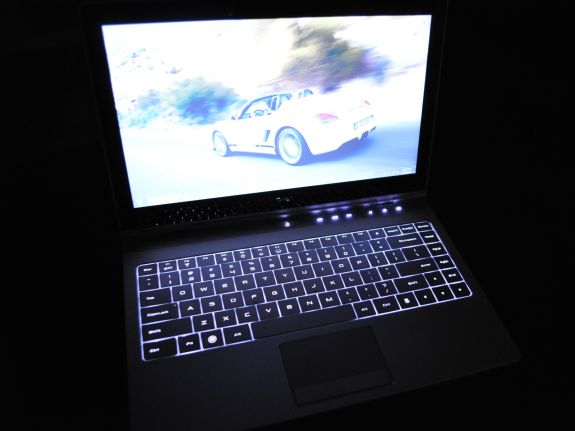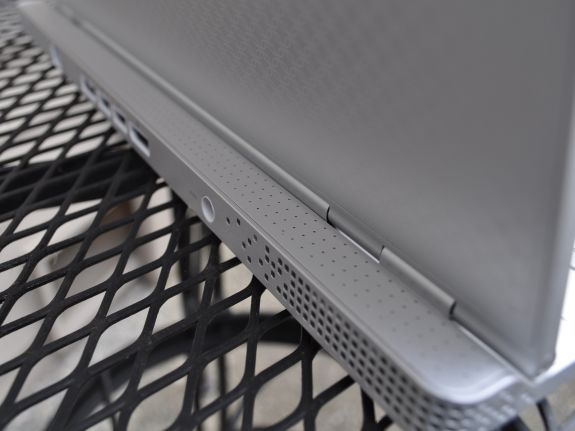Dell Adamo 13: CULV Goes Upscale
by Vivek Gowri on July 6, 2010 1:51 AM ESTDell Adamo 13: Industrial Design and Build Quality
The Adamo is stunning to behold. There simply is no better word to describe it. And oh man, is it thin. Best comparison: when closed, the Adamo is roughly as thick as the bottom casing of the 13” MacBook Pro. Yeah.
Dell really outdid themselves with the Adamo. Every exterior surface is either glass or machined aluminum. The bottom casing is a single piece of aluminum, a la Apple, and it’s less than a half inch thick. The LCD lid is half glass, half aluminum and surprisingly rigid for something so thin.
All of Apple’s products follow the design principles laid out in Dieter Rams’ 10 Commandments, which pretty much condenses to “Thou shalt be minimal, thou shalt be elegant, thou shalt be functional.” Dell took those design principles and then added some bling to it. Where Apple’s laptops feature clean surfaces and body panels, the Adamo has a visually interesting pattern on the aluminum part of the lid and the bottom of the notebook, not to mention the polished aluminum strip in the middle of the lid. Remarkably, even with the gloss and the aluminum brightwork, the Adamo doesn't look overdone. It has just enough glitz to be eye-catching, but not too much to be a distraction.
The chassis is just a single piece of aluminum, milled out from a thick sheet of aluminum. However, it appears that Dell's engineers reduced the thickness of the aluminum beyond normal levels, presumably to create as much space for the internal components, but they went far enough to allow for a fair amount of flex throughout the chassis. The body of the notebook and the LCD lid are both fairly sturdy given the thinness, but overall when compared to the similarly thin MacBook Air, the Adamo isn't as rigid or as solid structurally. There's some perceivable flex, which is unexpected in such a premium-level device. Also, the screen shows quite a bit of ripple effect under pressure. Again, given the thinness, it's not unexpected, but don't expect this to be a particularly rugged system.
What the thinness can't explain away is the quality of the keyboard. I was pretty hopeful about the backlit keyboard, with it's full size keys, logically laid out keys, and stylishly modern font on the keys. As with the rest of the notebook, it's one of the most elegant looking of its kind. However, the feel is pretty poor - the keys themselves feel plasticky and cheap, and there's perceptible flex. Not a lot mind you (how much give could there be on a .65" thick laptop?), but it just doesn't feel particularly well put together or built to last. The backlighting is pretty weak, so against the silver keyboard it makes it pretty difficult to see in higher light situations. But in the dark, the backlighting is a great feature to have.
The touchpad is pretty nice, I like how the metallic surface feels and the multitouch works well. The buttons themselves are nothing special, they work. The real story with the touchpad is the detailing - the subtle pattern of concentric circles machined into the touchpad surface, how the touchpad buttons integrate with the rest of the touchpad, the polished aluminum ring around the touchpad, etc. It's beautiful, and the detailing is marvelous, which is the Adamo's raison d'etre.
Ports are sparse, but not as limited as on the MacBook Air. In comparison to the almost laughable single USB, micro-DVI port, and headphone/mic combo jack on Apple's superthin portable, the Adamo has a pair of USB ports on the rear panel, joined by a DisplayPort video out, an eSATA/USB combo port (a rarity on ultraportable computers), and Gigabit Ethernet. On the right side, we have a combination headphone/mic port and a built in SIM card slot for 3G data. Interestingly, the SIM slot is designed the same way as the iPhone's SIM card tray and rendered in anodized aluminum, evoking memories of the original iPhone's SIM slot. There's also a 1.3MP webcam and a mic, which work well for Skype.
The speakers are mounted on the extrusion beyond the LCD hinge, presumably because they wouldn't fit anywhere else in the chassis. Unfortunately, this means everyone else around you can hear what's going through your speakers better than you can. The speakers aren't that great, and frequently you want more volume from them. This likely has more to do with them being behind the screen and less to do with the speakers themselves. More impressive is the actual speaker grille, with laser cut holes to let the sound through and a single status light concealed in the middle. The grille is attached magnetically (though it needs to be pried off and doesn't remove easily) and covers the Windows COA sticker along with some of the chassis screws. Putting that much engineering and design thought towards a normally minor piece like the speaker grille again just goes to show how much attention Dell paid to every painstaking detail during the design process of the Adamo.



















67 Comments
View All Comments
MrSpadge - Tuesday, July 6, 2010 - link
You might want to take a look at the new Thinkpad X201 using Core iSomething.Stokestack - Tuesday, July 6, 2010 - link
Except for the glossy screen. Glossy screens are the biggest regression in personal computing ever.The current fraud of glossy screens originated with third-tier products being peddled at Best Buy and Costco. It's sad to see companies like Apple following their lead, to the detriment of their customers.
sebmel - Wednesday, July 7, 2010 - link
I read AnandTech because of the intelligence & depth of the articles. This one is a disappointment. It reads like a paid for vanity piece for Dell.For example:
"Apple’s products follow the design principles laid out in Dieter Rams’ 10 Commandments, which pretty much condenses to “Thou shalt be minimal, thou shalt be elegant, thou shalt be functional.” Dell took those design principles and then added some bling to it."
I do not believe Anand would have written such a confused, illogical statement.
Minimalism with added bling?
What is that? Elegance with added vulgarity? Refined taste with added redneck?
The article comes to the conclusion:
It's slow
The keyboard is cheap
The speakers are lousy and in the wrong place
The battery life is poor
The screen's mediocre
It's pricey
But look at the bling!!
Well, what is there to look at? This miracle of industrial design is designed like an ice-cream tub... a tray with an inset top, resulting in an ugly seam. They combine that with an ugly exposed hinge and an ugly ledge behind it.
It is covered in immature touches like: the irregular material use and finishing... 4 finishes on the top alone; irregularly cut vents; white plastic inserts on sockets; an ugly squared of shape dictated by the cheap tub design.
Let me give a word of warning to those who may be thinking of buying this based on the recommendation that the 'bling' deserves respect.
Do you see that band of polished aluminium on the top? That will be painted with varnish to stop oxidation. That varnish will scratch and fail. Oxygen will get behind it and the aluminium will oxidise white, bubbling up.
That isn't clever design & it isn't going to look: bling for long... even if you learnt your idea of good taste from pimps.
As for using Dieter Rams' name in the description of this product, please, show a little more taste. You may as well have quoted Bertrand Russell in an article about Forest Gump:
"Laif is laak a baax a chaaclets..."
rtothedizzy - Wednesday, July 7, 2010 - link
You don't like the design. I get it. That's fine, to each his own.But oxidizing the aluminum strip???
Not to get too crazy into the details but any and all aluminum you see is oxidized. Aluminum and O2 in the air react in less than a nanosecond to make an oxide layer a few nm thick on all exposed aluminum surfaces. That oxide layer protects the rest of the aluminum below the surface from being oxidized and has little effect on the appearance of the metal.
sebmel - Wednesday, July 7, 2010 - link
I am afraid that is not the case. Aluminium does not oxidise immediately and the process of oxidations does not stop at the surface when that surface is covered with lacquer.The oxide and dirty get under a lip of varnish and the tarnishing is worse than exposed aluminium.
Aluminium oxide is white. In order for a manufacturer to prevent an aluminium object from becoming dull it is necessary to varnish it. Yes, aluminium does oxidise readily, but not so fast that it cannot be polished, or brushed, and then lacquered.
An aluminium Audi R8:
http://farm5.static.flickr.com/4025/4530109473_818...
Apple made this error with the latch buttons on the MacBook Pros. As a solution they moved to neodymium magnets.
An example of the corrosion purchasers of this Dell laptop can expect:
http://farm3.static.flickr.com/2122/2199107630_340...
rtothedizzy - Wednesday, July 7, 2010 - link
I'm afraid it is the case.From the textbook "Corrosion Basics: An Introduction":
"The factor which assures the long life of aluminum is its self forming microscopically thin surface layer of aluminum oxide. This layer is so thin that it is measured in atomic units. The air-formed film on new aluminum surfaces is about 2.5 nm thick, while the film on aluminum that is several years old may be 10 or more nm thick"
We can get into oxidation rates some other time.
Assuming you really wanted to polish and brush some Al and then lacquer it I'm sure there is a way but it really shouldn't be necessary. There are plenty of other ways to get a shiny surface on a metal (Al included) that would require none of the above.
Chances are in this case the Al has been anodized (which makes it even MORE corrosion resistant) and electroplated with something shiny (chromium perhaps).
The only way you're going to have oxidation problems with Al is if it's alloyed with some other easily corroded metal or if you expose it certain chemicals.
sebmel - Friday, July 9, 2010 - link
All you have to do is look at the pictures of the Audi and the Dell laptop to see that they were not anodised. They have a very obvious layer of transparent lacquer on them.As for immediate oxidation: no, it is not necessary to polish and lacquer aluminium in an anaerobic environment because the metal does not oxidise to a dull finish instantly, as lithium does.
If one must be pedantic it is correct to say that oxidation does start immediately but not fast enough to hinder lacquering... just buff up an aluminium pot and watch it.
As for the oxidation stopping. No it doesn't. The aluminium industry likes to say it does but it doesn't. Again... look at some kitchen pots. Look at one used yesterday, last week and last month... they do not look the same... they don't even feel the same on the surface. To anyone who uses aluminium pans (and I don't recommend you do) this is obvious.
mojohacker2010 - Saturday, July 10, 2010 - link
HE gave you a SOURCE and cited word for word from the source to support his argument, AND YOU RESPONDED WITH YOUR OPINIONS, not facts, and by saying "No it doesn't."sebmel - Monday, July 12, 2010 - link
There are two ways to learn: one is to read and repeat what you have read and the other is to think and research (as the people who wrote the books did).So use the second method, please. Abrade an aluminium pan. If it oxidises in milliseconds to a dull whitish grey then rtothedizzy is correct.
If it stays shiny for say 5 minutes, long enough to lacquer, then I am correct. And you'll have found the answer without any need for that caps lock ranting.
sebmel - Monday, July 12, 2010 - link
Having looked more closely at the photos it looks probable that the aluminium band on the lid isn't lacquered. If that is the case then it needs to be pure aluminium to resist corrosion well. As you pointed out, the alloys are not so resistant.However, there is still an issue with sweat, which can be pH4... aluminium oxide is stable between pH5 and pH9 (I haven't the exact figures).
Here's some sweat induced corrosion on a gun:
http://themartialist.com/images/cherrysnub03.jpg
and here, again, is the same thing happening on a MacBook Pro:
http://farm3.static.flickr.com/2122/2199107630_340...
Just for good measure, here's a badly corroded aluminium iPod:
http://admintell.napco.com/ee/images/uploads/apple...
This is a rather long defence of a simple comment:
That aluminium strip on the lid is liable to corrode. The plate on the base too. The anodised parts will be more resistant.